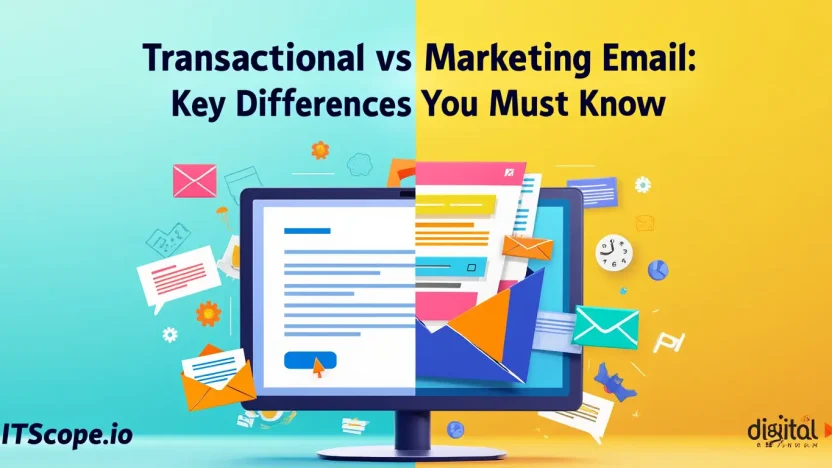In the digital age, email remains a pivotal communication channel, but not all emails are created equal. Enter: the battle of Transactional vs Marketing Email. Whether you’re a seasoned digital marketer or a tech-savvy entrepreneur, understanding the distinctions between these two is crucial for crafting a bulletproof email strategy. Transactional emails deliver important information that every user needs, while marketing emails aim to captivate and convert with powerful messaging. Clarity on these differences can unlock doors to higher engagement and conversion rates!
Ready to dive deeper into this email dichotomy? Let’s unpack the key differences and what they mean for your business tactics.
Table of Contents
- Understanding Transactional Emails
- Decoding Marketing Emails
- Comparing Goals: Informational vs Promotional
- Regulatory Considerations for Each Type
- Best Practices for Balancing Transactional and Marketing Emails
- Conclusion
Understanding Transactional Emails
Transactional emails are essential for any business striving to keep its processes smooth and clients informed. These emails are automated, sent in response to a user’s interaction with a company’s website or application. Unlike marketing emails, they focus on providing necessary information rather than promoting products or services. So, what exactly qualifies as a transactional email?
Fact: Transactional emails boast an open rate of 60-80%, significantly higher than marketing emails.
Examples of Transactional Emails
- Order Confirmations: When a customer completes a purchase, they receive a detailed order confirmation.
- Password Resets: Users seeking to change passwords trigger these immediate, secure emails.
- Shipping Notifications: Keeps customers informed about the status of their shipped items.
- Account Updates: Alerts about changes or updates to user accounts ensure security and awareness.
Imagine shopping online and receiving an instant order confirmation—no doubts, immediate assurance. That’s the power of a transactional email. Its primary job is to drive action by responding to user-initiated events.
Importance of Transactional Emails
- Enhances Trust: Provides predictable and timely information, establishing customer trust.
- Improves Customer Experience: Offers seamless communication, enhancing user satisfaction.
- Boosts Engagement: High open rates mean more user interaction and engagement.
The next time you think about your communication strategy, remember how transactional emails, in a largely automated manner, build strong customer relationships by delivering instant, vital information right when it’s needed.
| Email Type | Primary Use |
|---|---|
| Order Confirmation | Purchase Verification |
| Password Reset | Account Security |
| Shipping Notification | Delivery Updates |
Decoding Marketing Emails
Ever wonder what sets marketing emails apart in the bustling world of comprehensive email strategies? Understanding the essence of marketing emails is crucial in the broader discussion of transactional vs marketing email strategies. Let’s dive into what makes a marketing email tick and how it leverages creativity and strategy to engage its audience.
Marketing Emails: These are messages delivered directly to potential customers with the primary aim of promoting or selling a product or service. Unlike transactional emails, marketing emails are about building relationships and driving conversions.
Key Features of Marketing Emails
- Rich Content: Includes eye-catching graphics, engaging copy, and CTAs that entice the reader to act.
- Personalization: Harnesses data to tailor messages to the recipient’s preferences and behaviors.
- A/B Testing: Often utilizes A/B testing to optimize subject lines, content layout, and timing for better engagement.
Marketing Email Strategies
Building relationships with engaging content is the heart of effective marketing emails.
Successful marketing emails often integrate into broader digital marketing campaigns. By utilizing data and analytics, marketers can refine their messaging strategies to resonate with their audience. For more on effective email strategies, click here Email Marketing Keywords: The Ultimate Guide to Campaign Success
| Feature | Description |
|---|---|
| Aesthetic Design | Focuses on visually appealing formats to attract attention. |
| List Segmentation | Targets specific audience groups for higher engagement. |
Comparing Goals: Informational vs Promotional
Ever wondered what separates a transactional email from a marketing email? It all boils down to their core objectives. Transactional emails focus on informational exchanges. Think order confirmations or password resets. Their main goal is to convey crucial information to your subscribers in a timely manner.
In contrast, marketing emails are crafted to promote your brand. Whether it’s a holiday sale or a new product release, this type of email aims to engage and convert leads into customers.
| Type | Goal |
|---|---|
| Transactional Email | Informational |
| Marketing Email | Promotional |
When you understand these differences, you can tailor your email strategy more effectively. Focus on the transactional versus marketing email roles to achieve your desired outcomes. Want to inform or to persuade? The choice determines your content choice and call-to-action strategy.
The Ultimate Guide to Building Powerful Connections for more on optimizing each email type for maximum engagement and impact.
Regulatory Considerations for Each Type
In the realm of transactional vs marketing email, understanding regulatory boundaries is vital. While transactional emails confirm or facilitate a commercial transaction, marketing emails aim to promote products or services, thus facing stricter guidelines.
| Email Type | Regulatory Requirement |
|---|---|
| Transactional Email | Often exempt from anti-spam laws, but must include a clear relationship with the transaction. |
| Marketing Email | Requires explicit consent under laws like the CAN-SPAM Act and GDPR. |
Regulations shape how brands communicate. While transactional emails can navigate more freely, marketers must tread carefully, securing permissions and disclosures. Consider subscribing to updates on relevant regulations to stay compliant in your strategy. What steps will you take to ensure compliance in your transactional vs marketing email strategy?
Stay informed on email compliance with resources like https://jatheon.com/blog/email-compliance-email-archiving/
Best Practices for Balancing Transactional and Marketing Emails
Striking a balance between transactional vs marketing email types ensures you engage without overwhelming your audience. Focus on delivering value while respecting inbox space. Here’s how:
- Tactical Scheduling: Time your marketing emails strategically to avoid conflict with transactional messages. Consistency builds trust.
- Clarity is King: Use clear, decisive language to separate action-driven transactional emails from promotional content.
- Permission-Based: Prioritize consent and respect preferences to maintain credibility and drive engagement.
Mastering these practices not only enhances communication but also boosts customer relationship.
Conclusion
Understanding transactional vs marketing email is crucial. Each serves distinct purposes; transactional emails provide essential information, whereas marketing emails aim to engage and convert. Mastering both enhances communication and leverages opportunities effectively.



